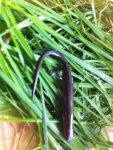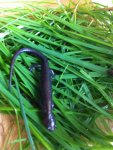gguillot
New member
- Joined
- Oct 24, 2012
- Messages
- 3
- Reaction score
- 0
- Points
- 0
- Location
- Peapack Gladstone NJ
- Country
- United States
Hello All…I found a salamander yesterday morning on the sidewalk of our local library. Initially, I thought it was dead and picked it up to show my 6 year old when she got home from school because I am that type of Mom. However, once I got it to the car it started to wiggle a little(it was a chilly, rainy day)…clearly it is injured near the mouth area…and I thought perhaps the warmth of my hand perked it up as well as the fear of being picked up by a human. The question is…how do I care for it while it is ill, is there any hope for this poor creature and if euthanasia is the best option to avoid suffering. We have a couple of well established freshwater tanks(although one has a large blue crayfish and another large community fish fish heavily planted)and couple of hospital tanks that aren’t being used at the moment and I could use for this little guy if necessary. So far, I have it in a container (draped for darkness) with fresh grass and moss from our yard and water under the grass and moss from one of the fish tanks. I gave it a quick dip in Melafix highly diluted with fish tank water which I hope it’s not a problem(I did read it was a safe treatment on Axolotls.org). It seems more active today and I am not sure that I will be able to bathe it again without causing harm…is one time enough or should I make a mist to spray on it? Aside from that, I am using the loving neglect approach and checking it every 4-6 hours….don’t want to stress it more the necessary. BTW, I only use Seachem products in all my tanks and use a charcoal/crushed coral filters. I am not certain what species this creature is either…and I have looked extensively and the closest I would say would be the garden slender salamander(but we live in NJ and they are found in the CA and Mexico). It is no more than 3inch long and nearly solid dark gray black except for its sides which have a bluish gray very tiny speckled pattern. I will post a picture. Thanks in advance for any help.


